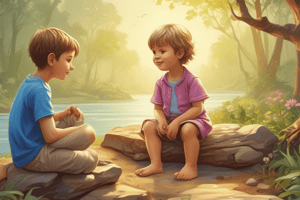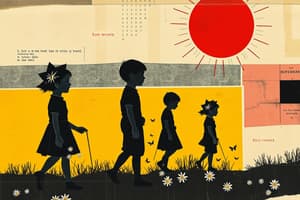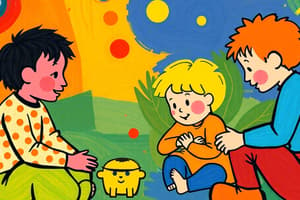Podcast
Questions and Answers
What does Sarah say when Megan tries to touch the baby?
What does Sarah say when Megan tries to touch the baby?
- Don't touch her, she's sleeping. (correct)
- Leave her alone, Megan.
- You can play with her.
- It's okay to touch her.
Megan puts on a red skirt before sitting at the table.
Megan puts on a red skirt before sitting at the table.
False (B)
What does Sarah pretend to do while the baby sleeps?
What does Sarah pretend to do while the baby sleeps?
doing dishes
Megan stirs the spoon in a cup and asks Sarah, 'Would you like a cup of ______?'
Megan stirs the spoon in a cup and asks Sarah, 'Would you like a cup of ______?'
What item does Megan take out from the wardrobe?
What item does Megan take out from the wardrobe?
Sarah is playing by herself in the home corner.
Sarah is playing by herself in the home corner.
What does Sarah do after pretending to drink tea?
What does Sarah do after pretending to drink tea?
Match the following actions to the characters involved:
Match the following actions to the characters involved:
What is one item Sarah needs to buy from the shops for their picnic?
What is one item Sarah needs to buy from the shops for their picnic?
Megan suggests that they do not need hats for their walk to the shops.
Megan suggests that they do not need hats for their walk to the shops.
What does Megan say she will get for the picnic?
What does Megan say she will get for the picnic?
Sarah sits on the __________ chair and sings a lullaby.
Sarah sits on the __________ chair and sings a lullaby.
Match the categories of play with their contributions to development:
Match the categories of play with their contributions to development:
Which of the following is NOT one of the chapter's objectives?
Which of the following is NOT one of the chapter's objectives?
The chapter consists of five objectives related to understanding play.
The chapter consists of five objectives related to understanding play.
Megan and Sarah are making a shopping __________ for their picnic.
Megan and Sarah are making a shopping __________ for their picnic.
What is the primary benefit of solitary play for children?
What is the primary benefit of solitary play for children?
Children who engage in solitary play are often aware of others around them.
Children who engage in solitary play are often aware of others around them.
When does solitary play typically begin in a child's life?
When does solitary play typically begin in a child's life?
Engaging in solitary play allows children to explore freely and prepare themselves to play with __________.
Engaging in solitary play allows children to explore freely and prepare themselves to play with __________.
Which of the following best describes solitary play?
Which of the following best describes solitary play?
Match the developmental aspect with its description:
Match the developmental aspect with its description:
Solitary play is uncommon in toddlers due to their social development.
Solitary play is uncommon in toddlers due to their social development.
How does solitary play prepare children for future social interactions?
How does solitary play prepare children for future social interactions?
What characterizes associative play?
What characterizes associative play?
Associative play allows children to play together in a meaningful way.
Associative play allows children to play together in a meaningful way.
At what developmental stage does associative play begin?
At what developmental stage does associative play begin?
In associative play, children do not set ______.
In associative play, children do not set ______.
Match the types of play with their key characteristics:
Match the types of play with their key characteristics:
What is a key aspect of associative play?
What is a key aspect of associative play?
Cooperative play is a less sophisticated type of play compared to associative play.
Cooperative play is a less sophisticated type of play compared to associative play.
What allows children to begin practicing social skills during play?
What allows children to begin practicing social skills during play?
According to Bloom, play consists of activities that are:
According to Bloom, play consists of activities that are:
Albon defines play as an activity that is primarily solitary and lacks emotional engagement.
Albon defines play as an activity that is primarily solitary and lacks emotional engagement.
What is the primary characteristic of play according to Sutton-Smith?
What is the primary characteristic of play according to Sutton-Smith?
According to Albon, play is accompanied by feelings of __________ and joy.
According to Albon, play is accompanied by feelings of __________ and joy.
Match the theorists with their definitions of play:
Match the theorists with their definitions of play:
Which of the following theorists describes play as differing from ordinary life?
Which of the following theorists describes play as differing from ordinary life?
Sutton-Smith suggests that play may sometimes be a reflection of life's worth.
Sutton-Smith suggests that play may sometimes be a reflection of life's worth.
What are the key elements of play as described by the theorists mentioned?
What are the key elements of play as described by the theorists mentioned?
Which factor directly affects the quality of play environments provided by educators?
Which factor directly affects the quality of play environments provided by educators?
Educators’ beliefs about play have no significant impact on the learning experiences of children.
Educators’ beliefs about play have no significant impact on the learning experiences of children.
What should educators do to enhance play experiences for children?
What should educators do to enhance play experiences for children?
Educators who value play are more likely to provide a choice of learning experiences and to __________ with children.
Educators who value play are more likely to provide a choice of learning experiences and to __________ with children.
According to the content, which of the following is likely to have a positive effect on children's learning?
According to the content, which of the following is likely to have a positive effect on children's learning?
Educators' attitudes towards play do not affect children's social environment.
Educators' attitudes towards play do not affect children's social environment.
What does EYLF stand for?
What does EYLF stand for?
Match the following concepts with their definitions:
Match the following concepts with their definitions:
Flashcards
Sarah's activity
Sarah's activity
Sarah pretends to do dishes while her baby sleeps.
Megan's interaction
Megan's interaction
Megan interacts with the home corner by playing dress-up and offering a cup of tea
Playing Tea Party
Playing Tea Party
Sarah and Megan act like they are having tea at a table.
Sarah's role
Sarah's role
Signup and view all the flashcards
Megan's role
Megan's role
Signup and view all the flashcards
Rules
Rules
Signup and view all the flashcards
Object usage
Object usage
Signup and view all the flashcards
Child Development
Child Development
Signup and view all the flashcards
Play characteristics
Play characteristics
Signup and view all the flashcards
Play categories
Play categories
Signup and view all the flashcards
Play types
Play types
Signup and view all the flashcards
Supporting play
Supporting play
Signup and view all the flashcards
Play description
Play description
Signup and view all the flashcards
Play and development
Play and development
Signup and view all the flashcards
Play vs. other activities
Play vs. other activities
Signup and view all the flashcards
Play-based approach
Play-based approach
Signup and view all the flashcards
Solitary Play
Solitary Play
Signup and view all the flashcards
Benefits of Solitary Play
Benefits of Solitary Play
Signup and view all the flashcards
Infancy and Solitary Play
Infancy and Solitary Play
Signup and view all the flashcards
Child's Absorption
Child's Absorption
Signup and view all the flashcards
Solitary Play and Independence
Solitary Play and Independence
Signup and view all the flashcards
Limited Interaction
Limited Interaction
Signup and view all the flashcards
Exploration via Solitary Play
Exploration via Solitary Play
Signup and view all the flashcards
Solitary Play's Development
Solitary Play's Development
Signup and view all the flashcards
Associative Play
Associative Play
Signup and view all the flashcards
Associative Play - Age
Associative Play - Age
Signup and view all the flashcards
Associative Play - Characteristics
Associative Play - Characteristics
Signup and view all the flashcards
Associative Play - Link to Other Play Types
Associative Play - Link to Other Play Types
Signup and view all the flashcards
Cooperative Play - Description
Cooperative Play - Description
Signup and view all the flashcards
Cooperative Play - Progression
Cooperative Play - Progression
Signup and view all the flashcards
Onlooker play characteristics
Onlooker play characteristics
Signup and view all the flashcards
Parallel play characteristics
Parallel play characteristics
Signup and view all the flashcards
EYLF's Role
EYLF's Role
Signup and view all the flashcards
Educator's Beliefs about Play
Educator's Beliefs about Play
Signup and view all the flashcards
Impact of Adult Beliefs
Impact of Adult Beliefs
Signup and view all the flashcards
Educator's Knowledge
Educator's Knowledge
Signup and view all the flashcards
Critical Examination of Beliefs
Critical Examination of Beliefs
Signup and view all the flashcards
Value of Play
Value of Play
Signup and view all the flashcards
Choice in Learning
Choice in Learning
Signup and view all the flashcards
Educator Engagement
Educator Engagement
Signup and view all the flashcards
Play: Lifter & Bloom
Play: Lifter & Bloom
Signup and view all the flashcards
Play: Albon
Play: Albon
Signup and view all the flashcards
Play: Sutton-Smith
Play: Sutton-Smith
Signup and view all the flashcards
Play: Intentional States
Play: Intentional States
Signup and view all the flashcards
Play: Spontaneous Activities
Play: Spontaneous Activities
Signup and view all the flashcards
Play: Objects of Interest
Play: Objects of Interest
Signup and view all the flashcards
Play: Tension and Joy
Play: Tension and Joy
Signup and view all the flashcards
Play: Free-Ranging
Play: Free-Ranging
Signup and view all the flashcards
Study Notes
Part 1: Theories and Perspectives on Play
- This textbook provides an overview of play and play-based pedagogy
- The first three chapters focus on answering the question "What is play?"
- Chapter 1 defines play, outlining its key characteristics and types.
- Chapter 2 reviews historical and contemporary play theories.
- Chapter 3 investigates play-based pedagogies in early childhood contexts.
Vignettes
- Home corner play observation:
- Sarah (4) and Megan (4) engage in pretend play, role-playing, interacting and sharing.
- Sarah takes on the role of caregiver, while Megan takes on other roles.
- They negotiate roles, share materials, and create a scenario around a specific need (eg., feeding a baby)
- Sand play observation:
- Jane (5) and Kate (5) engage in pretend play with sand, making and decorating "cakes," and using tools.
- They take on roles, imitate the actions of adults, and create a pretend scenario.
- Michael (4) and Brodie (4) also engage in pretend play using a variety of tools to manipulate the sand. They explore, experiment, and interact with the tools.
Chapter Objectives
- Chapter objectives:
Describe the classical theories of play. Discuss their influence on early childhood educators' work. Identify major play scholars and their contributions. Recognize relevant play theories in the EYLF. Review contemporary theories of play.
Introduction
- Psychologists, play scholars, and educators have researched the role of play in development.
- This book explores play within early childhood (EC) contexts.
- The key question "What is play?" is addressed, focusing on definitions, key characteristics, and different types.
- Play's role in development and learning is connected to nine key characteristics.
- The text is structured into four parts: Theories and Perspectives on Play, Constructive Approach, Curriculum, Policy and Planning for Play, and Considerations for Educators.
Chapter Summary(Part 1)
- Understanding of play varies across EC settings.
- The EYLF provides a context for play as an important element of learning.
- Play displays crucial characteristics across different age groups and development stages.
- Various play categories contribute significantly to children's holistic development.
Chapter Summary (Part 2)
- Classical theories, popular during the late 19th and early 20th centuries (Froebel, Rousseau, Pestalozzi), emphasised physiological and evolutionary explanations of play.
- Various perspectives, such as Surplus Energy Theory, Recreation/Relaxation Theory, Practice/Pre-exercise Theory, and Recapitulation Theory, illustrate historical views of play's role.
- Contemporary theories (Psychoanalytic, Arousal-Seeking/Modulation, Meta-communicative, and Cognitive) focus on play's impact on social-emotional and cognitive learning, considering its connections with child development.
Activities
- Activities include analyzing different forms of play, theorizing about play impacts on children, evaluating how play benefits children's learning, and researching play in educational contexts beyond one's own.
Studying That Suits You
Use AI to generate personalized quizzes and flashcards to suit your learning preferences.




